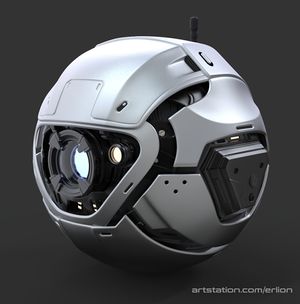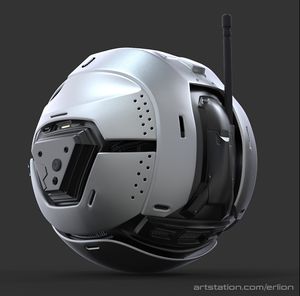No edit summary |
No edit summary |
||
| Line 1: | Line 1: | ||
{{Disambiguation Notice|type=technology|name=probe}} | |||
[[File:nikolay-temnikov-1.jpg|thumb]] | [[File:nikolay-temnikov-1.jpg|thumb]] | ||
[[File:nikolay-temnikov-2.jpg|thumb]] | [[File:nikolay-temnikov-2.jpg|thumb]] | ||
Revision as of 18:49, 11 April 2021
Template:Disambiguation Notice


- Cruising Speed
- 300 kph
- Maximum Speed
- 1000 kph
- Nominal Range
- 1 Meter - 1 AU from Vessel
- Maximum Range
- 21 AU Control
2.5 ly Relay
The newly developed Teufel Sensor Probe is an entirely new design in remote sensing and threat assessment. These are small 1.7 meter diameter truncated-sphere probes that are launched from a ship. The probes are small and constructed of energy absorbent materials making them extremely difficult to detect, they operate on a micro-gravity displacement generated within the core by a Spacial Variance Reactor. The probes have a simple AI system that allows them to be given simple commands from their operator on what they are to do. The primary purpose is to fly near to the ship and relay sensor information back to the ships main computer and command center. They carry a full sensor suite of short-range and long-range sensors. They can operate independently or in groups, when in groups they can magnify their sensor strength by arranging themselves into array patterns for higher sensitivity.
Since they are unmanned they may turn in any direction in three-dimensional space within microseconds, which they routinely do along their programmed flight path to form an exceptionally erratic and difficult to track path of movement. The onboard AI is capable of being directly told to fly in a direction in a straight line, however under normal operations they are given a pattern to follow that includes how far off the directed course they are permitted to go at any given time. The AI will then plot random course changes (or at times not-so-random to give a more varied sensor reading) in order to avoid detection.
The ship is capable of handling 20 Teufel Probes in operation at the same time.
Communications
The probes are capable of communicating not only with the vessel which launched them but with each other. They normally employ precisely timed direct point to point subspace enhanced direct beam communications (similar to laser pulse communications but operating faster than light) to communicate with each other. To communicate with their vessel they use subspace high frequency burst communications, or will use this to communicate with each other if required.
The probes operate on a multi-dimensional fractal encryption algorithm, the communications protocol changes the timing and frequency range of all subspace communications routinely so that only the vessel which launched the probes will know what channel, duration, and timing they are going to communicate on next. The encryption keys are also rotated frequently with a similar shared-key style that is synced at launch time.
When communicating with each other the probes use their own communications protocol which developed independently along a neural net algorithm and essentially learns and changes to suit each situation, this means that their inter-probe communication is unique to the ship they are launched from as well so that no two sets of probes can communicate with each other directly, the probes can only talk to the ship they were launched from or the other probes from that ship. All other communications will be ignored unless authenticated properly as coming from one of those two sources. To the probes, a set of probes from another vessel would essentially be speaking a different language and another vessel would be unable to guess the next communications channel, frequency, timing, or encryption key the probes intended to use.
As an additional security measure the signals can also be authenticated to a key tied to the ships transponder code from which they were launched. The key and transponder code go together, while one cannot guess the key from the transponder code it becomes blatantly obvious if a signal is being fraudulently sent trying to mimic their mother-ship even if the ships transponder codes match, their keys would not.
Offensive Deployment
While the probes are not designed to be offensive weapons, they can be deployed as such. The probes can be directed to overload their power cores on command creating a sizable explosion for their small size. Several probes detonating in concert with each other could be used as a last-ditch but quite effective weapon.